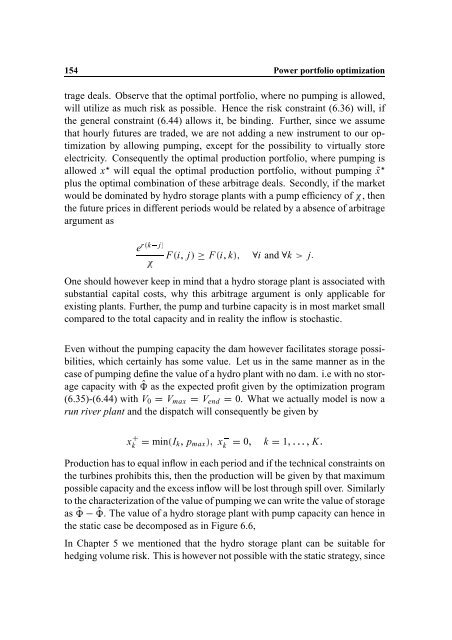Hedging Strategy and Electricity Contract Engineering - IFOR
Hedging Strategy and Electricity Contract Engineering - IFOR
Hedging Strategy and Electricity Contract Engineering - IFOR
Create successful ePaper yourself
Turn your PDF publications into a flip-book with our unique Google optimized e-Paper software.
e rÿ k ì<br />
j ¢<br />
è<br />
xëk<br />
minÛ I k Ü p max ÝaÜ x ìk<br />
0Ü k 1Ü<br />
154 Power portfolio optimization<br />
trage deals. Observe that the optimal portfolio, where no pumping is allowed,<br />
will utilize as much risk as possible. Hence the risk constraint (6.36) will, if<br />
the general constraint (6.44) allows it, be binding. Further, since we assume<br />
that hourly futures are traded, we are not adding a new instrument to our optimization<br />
by allowing pumping, except for the possibility to virtually store<br />
electricity. Consequently the optimal production portfolio, where pumping is<br />
allowed xú will equal the optimal production portfolio, without pumping xú<br />
plus the optimal combination of these arbitrage deals. Secondly, if the market<br />
would be dominated by hydro storage plants with a pump efficiency of è , then<br />
the future prices in different periods would be related by a absence of arbitrage<br />
argument as<br />
F Û iÜ jÝ F Û iÜ kÝaÜ i <strong>and</strong> k î j á<br />
One should however keep in mind that a hydro storage plant is associated with<br />
substantial capital costs, why this arbitrage argument is only applicable for<br />
existing plants. Further, the pump <strong>and</strong> turbine capacity is in most market small<br />
compared to the total capacity <strong>and</strong> in reality the inflow is stochastic.<br />
Even without the pumping capacity the dam however facilitates storage possibilities,<br />
which certainly has some value. Let us in the same manner as in the<br />
case of pumping define the value of a hydro plant with no dam. i.e with no storage<br />
capacity with ! as the expected profit given by the optimization program<br />
(6.35)-(6.44) with V 0 V max V end 0. What we actually model is now a<br />
run river plant <strong>and</strong> the dispatch will consequently be given by<br />
Ü K á á@á?á<br />
Production has to equal inflow in each period <strong>and</strong> if the technical constraints on<br />
the turbines prohibits this, then the production will be given by that maximum<br />
possible capacity <strong>and</strong> the excess inflow will be lost through spill over. Similarly<br />
to the characterization of the value of pumping we can write the value of storage<br />
! ! as . The value of a hydro storage plant with pump capacity can hence in<br />
the static case be decomposed as in Figure 6.6,<br />
In Chapter 5 we mentioned that the hydro storage plant can be suitable for<br />
hedging volume risk. This is however not possible with the static strategy, since
















